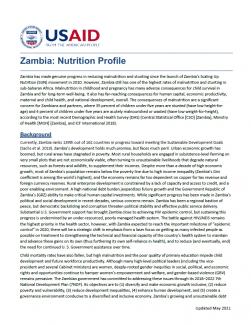Currently, Zambia ranks 139th out of 162 countries in progress toward meeting the Sustainable Development Goals (Sachs et al. 2019). Zambia’s development holds much promise, but faces much peril. Urban economic growth has boomed, but rural areas have stagnated in poverty. Most rural households are engaged in subsistence-level farming on very small plots that are not economically viable, often turning to unsustainable livelihoods that degrade natural resources, such as forests and wildlife, to supplement their incomes. Despite more than a decade of high economic growth, most of Zambia’s population remains below the poverty line due to high income inequality (Zambia’s Gini coefficient is among the world’s highest), and the economy remains far too dependent on copper for tax revenue and foreign currency reserves. Rural enterprise development is constrained by a lack of capacity and access to credit, and a poor enabling environment. A high national debt burden jeopardizes future growth and the Government Republic of Zambia’s (GRZ) ability to make critical human capital investments. While significant progress has been made in Zambia’s political and social development in recent decades, serious concerns remain. Zambia has been a regional bastion of peace, but democratic backsliding and corruption threaten political stability and effective public service delivery. Substantial U.S. Government support has brought Zambia close to achieving HIV epidemic control, but sustaining this progress is undermined by an under-resourced, poorly managed health system. The battle against HIV/AIDS remains the highest priority in the health sector, however, with Zambia expected to reach the important milestone of “epidemic control” in 2020, there will be a strategic shift in emphasis from a laser focus on getting as many infected people as possible on treatment to strengthening the technical and financial capacity of the country’s health system to maintain and advance these gains on its own (thus furthering its own self-reliance in health), and to reduce (and eventually, end) the need for continued U. S. Government assistance over time.
Child mortality rates have also fallen, but high malnutrition and the poor quality of primary education impede child development and future workforce productivity. Although many high-level political leaders (including the vice-president and several Cabinet ministers) are women, deeply-rooted gender inequities in social, political, and economic rights and opportunities continue to hamper women’s empowerment and welfare, and gender-based violence (GBV) remains pervasive. The Zambian government has committed to addressing these issues through its 2018–2022 7th National Development Plan (7NDP). Its objectives are to (1) diversify and make economic growth inclusive, (2) reduce poverty and vulnerability, (3) reduce development inequalities, (4) enhance human development, and (5) create a governance environment conducive to a diversified and inclusive economy. Zambia’s growing and unsustainable debt burden has implications for USAID programming. Official external debt rose to over $10 billion in 2018. Of this, $3 billion is currently owed to China, but another $6–8 billion is estimated to be in the pipeline (contracted but not disbursed) through various opaque lending agreements. The International Monetary Fund (IMF) estimates overall public debt (external and internal) to be 71 percent of Zambia’s annual gross domestic product (GDP), up from 10 percent in 2011. The government spends 87 percent of its budget on debt servicing and wages, leaving little left for other priorities. Fiscal deficits also continue to rise and are currently about 10 percent of GDP. This budget burden undercuts progress toward Zambia’s financial self-reliance as the government is less able to make critical investments in health, education, and rural development, which also jeopardizes the sustainability of USAID investments.

